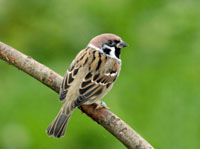Claro Tree Sparrow Project, 2009

A request to all woodland owners for assistance with the Claro Tree Sparrow Project from David Watkins, project manager:
The Tree Sparrow has seen a dramatic decline by between 50% and 80% across the UK in recent decades, the decline varying according to region and clearly apparent in the Harrogate area from the study of annual reports of the Harrogate and District Naturalists Society as far back as 1949. Tree Sparrows are primarily birds of lowland open parkland and farmland, requiring mature hedgerows and grassland areas for feeding, and mature trees, woodland edges and old farm outbuildings for roosting and usually colonial breeding.
Reasons for the decline of the Tree Sparrow include increased intensive agricultural practises, and loss of food sources and colonial breeding habitat. As a result the Tree Sparrow has been accorded Red List and Biodiversity Action Plan status. This means positive action is needed to arrest the decline. Fortunately it is one species which is easy to assist, at least in the short term while longer term land management systems can be introduced, which will incidentally benefit other declining farmland species eg Skylark, Grey Partridge, Lapwing and Corn Bunting. Tree Sparrows are coming increasingly readily to winter bird tables on the edges of towns, and in village and farm gardens. It also takes readily to nest boxes, and smaller garden colonies in villages and towns on the edge of agricultural areas are also much on the increase.
Harrogate Borough Council, Harrogate and District Naturalist Society and RSPB Group ( Harrogate ) are supporting a scheme to enable the purchase and placement of over 300 nestboxes throughout the area. The project will strengthen the existing schemes, which are mainly focussed to the north and east of Ripon, and establish a number of new larger colonies and a network of garden colonies in suitable areas.
A website www.treesparrows.com has been set up in support of the Project and allows visitors to learn more about their identification and habits, and to submit any sightings through a special page, which is already proving successful and which enables us to learn more about the distribution of Tree Sparrows throughout the area. We are keen to hear from owners of woodland within the project area of the Claro District, North Yorkshire who may have Tree Sparrows locally and who could perhaps offer to host a number of boxes along a woodland edge, preferably away from any disturbance. If you are unsure whether they occur I would be happy to visit, they can be overlooked particularly during the summer months. We are however pleased to hear from anyone involved in Tree Sparrow projects, and will be happy to feature them in our Newsletter. Similarly if you are not in our area please do visit the website and let us know where you are seeing Tree Sparrows or have them in the garden.
For help with identification of Tree Sparrows, click here
Comments are closed for this post.
Discussion
We live in the province of Alicante, Spain. Some years ago I constucted a nesting box hoping for longtailed tits as they often visit for water and to browse (greenfly ?) on our mature jacaranda. The box has never been used until this year when it was taken over by tree sparrows. At first all seemed to be well but now we see the male only who sits on the box or nearbye continuously chirping. I don’t like to disturb the box but I suspect that the female has died and the eggs are lying unhatched. Am I being fanciful or is he grieving for the loss of his family? This has gone on for a week or more now. I did not imagine that little birds could grieve that long.Could someone more knowledgeable please answer?

That is sad Douglas, have you any further news for us?
Tracy
7 July, 2009